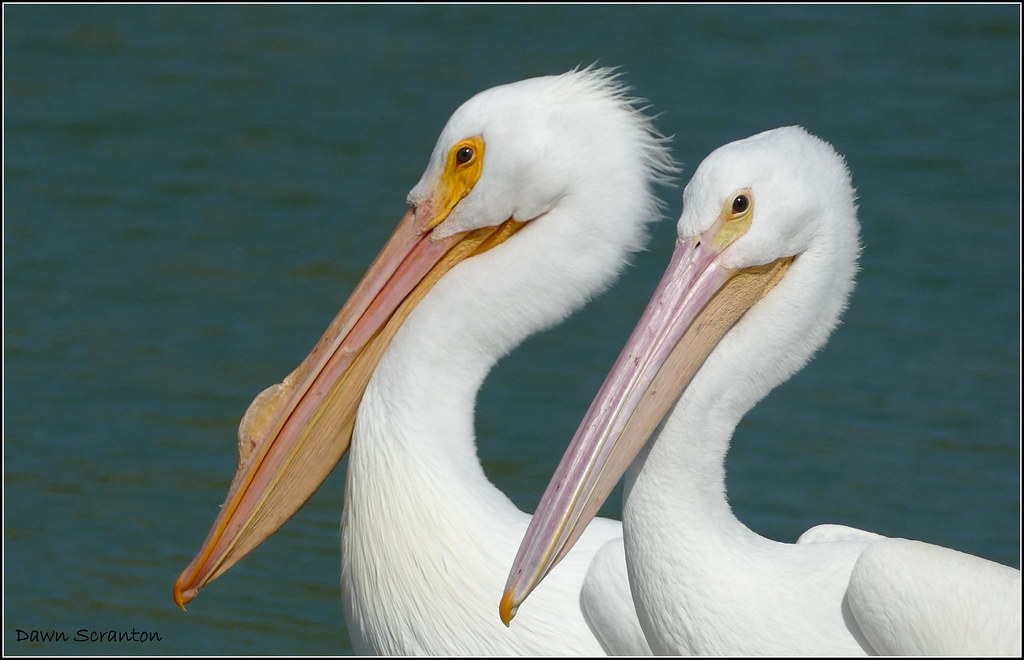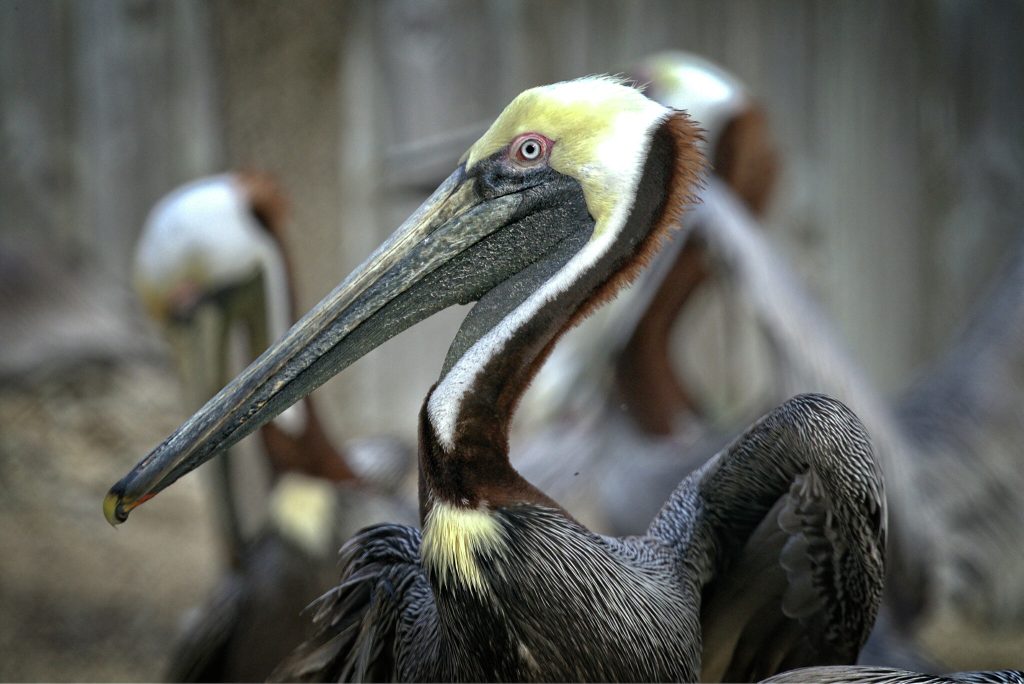Louisiana is home to two distinct species of Pelican, namely the Brown Pelican and the American White Pelican. Both can be sighted in this region.
While Brown Pelicans are present throughout the year, American White Pelicans are migratory birds that visit Louisiana during the winter season.
Pelicans are renowned for their massive bills, expandable throat pouches, and sturdy feet, making them easily recognizable. Despite their large size, they possess a lightweight build. Their skeletal structure and skin contain air pockets that contribute to their buoyancy, while their lengthy wings aid in graceful flight.
In the world, there exist a total of eight pelican species, with two of them inhabiting North America—the American White Pelican and the Brown Pelican.
During the breeding period, pelicans exhibit vibrant colors on their facial skin, throats, and bills. Some even develop additional structures on their bills.
Pelicans form breeding colonies consisting of up to 50,000 birds. Depending on the species, they may choose either ground or tree nests. After approximately 25 days of nesting, the young pelicans gather in “creches,” groups of up to 100 juveniles. Interestingly, the parents possess the ability to recognize and exclusively feed their own offspring.
Although pelicans prey on various animals, they are not classified as birds of prey, which exclusively refer to raptors. Their diet primarily consists of fish, but they are known to consume crabs, frogs, snakes, mammals, birds, and insects as well.
To catch fish, pelicans employ their throat pouches, which allow them to scoop up their prey and drain the water before swallowing it. Young pelicans also feed directly from their parents’ pouches.
This guide provides valuable information on identifying the pelican species present in Louisiana. It utilizes data gathered from avid birdwatchers on ebird and avibase, ensuring accurate details about the birds’ sighting patterns.
The Pelicans of Louisiana:
1. Brown Pelican
Brown Pelicans are a year-round presence in southern Louisiana, although they are more abundant during the winter months, spanning from November to April. These birds are observed in approximately 6% of summer checklists and 11% of winter checklists submitted by birdwatchers in the state.
Non-breeding adult Brown Pelicans feature white heads and necks with pale yellow foreheads. Their elongated bills exhibit a combination of yellow and orange hues. Their bodies showcase grayish-brown tones, complemented by short, black legs and webbed feet. Juveniles possess brown heads, necks, backs, and wings, while their bills appear bluish-gray. Their underparts exhibit a light brown shade.
Within the Brown Pelican species, there are five subspecies, two of which breed within the United States. The Pacific Coast variant is known as P.o.californicus, whereas the Atlantic Coast variant is identified as P.o.carolinensis.
The distinctions between the Pacific and Atlantic Brown Pelicans become more apparent during the breeding season. Both species display white heads with more vibrant yellow foreheads. The nape of their necks transitions from white to dark brown. Atlantic Brown Pelicans possess olive-brown throat pouches, while their Pacific counterparts exhibit red skin in this region.
Scientific classification: Pelecanus occidentalis
Length: 48 – 50 inches (122 – 127 cm)
Weight: 131.2 ounces (3718 g)
Wingspan: 78 – 84 inches (198 – 213 cm)
Brown Pelicans either breed and migrate or reside year-round along the Pacific and Atlantic Coasts of North America, extending southward to northern South America.
These pelicans typically inhabit shallow water environments. They are commonly found in estuaries, coastal marine habitats, mangrove islets, as well as resting on sandbars, breakwaters, and offshore rocks.
Brown Pelicans possess a remarkable foraging ability that distinguishes them. They are capable of diving into the depths of the ocean to capture their prey within their expansive throat pouches. Upon resurfacing, they skillfully drain the water, allowing them to immediately consume their catch.
Their diet primarily consists of fish such as sardines and herring. When not engaged in diving, they employ a more leisurely swimming approach, seizing prey with their bills. Additionally, they may consume crustaceans, frogs, eggs, and other young birds.
Brown Pelican vocalizations are typically limited to occasional grunts from adult individuals. However, juveniles may emit squawks when begging for food.
Brown Pelicans predominantly construct nests on the ground rather than in trees. These nests are often concealed and protected on islands, mangroves, and cliffs. The female pelican constructs the nest using reeds, leaves, pebbles, sticks, and soil. Each clutch consists of two to four eggs, which both parents incubate for approximately one month.
Interesting Fact: Brown Pelicans incubate their eggs by covering them with their webbed feet. Unfortunately, this practice became detrimental to their population due to the thinning of eggshells caused by the pesticide DDT. The weight of the parent’s feet would cause the eggs to break. Substantial conservation efforts were necessary to restore Brown Pelican numbers.
2. American White Pelican

American White Pelicans are more frequently observed in Louisiana during the winter season, although some individuals remain year-round. These pelicans are documented in approximately 1% of summer checklists and 11% of winter checklists.
American White Pelicans are majestic birds renowned for their large size and expansive wingspan, which ranks second among all North American bird species.
Non-breeding adult American White Pelicans possess a white plumage throughout their bodies, except for black flight feathers, which become visible during flight or when the wings are outstretched. Their eyes exhibit a bluish-gray shade, while their facial skin surrounding the eyes appears yellow. Pale orange tones adorn their bills, pouches, and feet. Juvenile American White Pelicans exhibit light gray feathers with darker brown napes.
During the breeding season, adult American White Pelicans display distinct coloration changes compared to their non-breeding counterparts. They develop a yellow plate on their upper bills, resembling a horn. Their bodies remain predominantly white, but their bills, eye region, legs, and feet adopt a brighter orange hue.
American White Pelicans undergo various molting stages, known as eclipse. In the spring, they exhibit a visible yellowish patch on their breasts and chests, while blackish feathers emerge on their heads during the summer.
- Scientific classification: Pelecanus erythrorhynchos
- Length: 60 – 63 inches (152 – 160 cm)
- Weight: 246.4 ounces (6983 g)
- Wingspan: 96 – 110 inches (244 – 279 cm)
American White Pelicans breed in remote inland lakes within North America before migrating to spend the winter along the southern Pacific Coast of the United States, the Gulf of Mexico, Mexico, and Central America. During migration, they can be observed in various states across western and central parts of the United States.
These pelicans typically inhabit shallow freshwater lakes, wetlands, and the perimeters of lakes and rivers. In winter, they frequent coastal bays, inlets, and estuaries, where they forage in shallow water and rest on sandbars.
American White Pelicans primarily feed on fish. They swim on the water’s surface, employing their sizable bills to capture prey. They also engage in group foraging, strategically coordinating their efforts to drive fish towards the shore, facilitating efficient scooping.
They are opportunistic feeders, always following the food source. They may embark on extensive journeys in search of favorable feeding grounds. Additionally, they consume crayfish, amphibians, salamanders, and are known to pilfer fish from other birds on the water’s surface.
When it comes to vocalizations, American White Pelicans are generally silent, emitting only occasional grunts. However, young pelicans within large colonies may become noisy as they beg for food.
Nests of the American White Pelican consist of simple, shallow depressions on the ground. The birds add twigs, sticks, reeds, and other materials atop the soil to provide protection for the eggs.
The female pelican then lays one to two eggs, which both parents diligently incubate for up to thirty-six days. Unfortunately, due to siblicide (when one sibling kills another), only one chick per nest typically survives.
Interesting Fact: The long, enormous bill of the American White Pelican can hold up to three gallons of water. By tilting their bills downward after scooping up fish from the sea, they drain the water, allowing them to swallow the remaining fish within their throat sacs.

